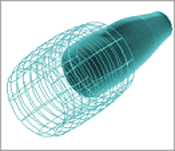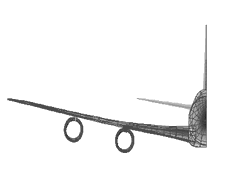|
|
|
|
 |
 |
 |
 |
AGPS also has
a number of analysis tools that are not found in
CAD systems. These permit a user to extract information
from points, curves, and surfaces that can be used
for evaluation or mathematical operations within
the programming language.
|
|
 |
 |
|
 |
|

|
 |
 |
 |
 |
Store the coordinates of point, curve, or surface objects
Physical coordinates or parametric derivatives of an AGPS object
Find the parameter value of a specified knot on a curve
Find the outward normal unit vector of a surface
Find the coefficients of a plane passing through three points
Store the coordinates of an AGPS point-matrix
Find the slope of a curve at a given parameter value
Find the S- and T-parameter values at a given index of a surface
Find the maximum chord height error between two parameter values
|
|
 |
 |
|
 |
|
 |
 |
 |
 |
 |
Determine the index of an ancestor of an AGPS object
Get the brand and brand-type system setting of an
object
Find the value of a particular descriptor
of an AGPS object
Find the number of ancestors of an AGPS object
Return the name of an AGPS object
Return Object Type
Find a user qualified-name for a given AGPS object |
 |
 |
|
 |
 |
|
 |
|
 |
 |
 |
 |
Perform matrix addition, multiplication, copying, and, scaling.
Clip matrix to an absolute value
Dot product between two vectors
Length of a vector
Cross product between two vectors
Normalize a vector
Determine Eigenvalues
Solve a system of linear equations
Find the inverse and determinant of a matrix
|
|
 |
 |
|
 |
|
 |
 |
 |
 |
 |
Return current level of numeric, character, and command keyword value tables.
Flags the most recent error type that occurred.
Find the dimensions of the current AGPS draw window
Store the rotation angles, scale, translation, and perspective field of view angle
Create interactive rubber-band window
Create default or user specified color pallet
|
|
 |
 |
|
 |
|

|
 |
 |
 |
 |
Smooth points, grids, and surface fitted grids by minimizing panel skewness
Smooth an array of 2D or 3D points using 2D Thompson Grid Equations with orthogonality
Smooth a lattice, list of arrays, or a point-matrix based upon 3D elliptic PDEs.
Smooth an array based upon 2D elliptic PDEs.
Smooth a specified sequence of points using a five-point smoother for a specified number of cycles
Minimize the grid area of an existing array by modifying the interior points
|
|
 |
 |
|
 |
|
|
|